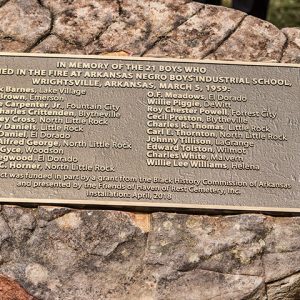calsfoundation@cals.org
Wrightsville (Pulaski County)
| Latitude and Longitude: | 34°36’08″N 092°13’01″W |
| Elevation: | 256 feet |
| Area: | 2.12 square miles (2020 Census) |
| Population: | 1,542 (2020 Census) |
| Incorporation Date: | January 3, 1973 |
Historical Population as per the U.S. Census:
|
1810 |
1820 |
1830 |
1840 |
1850 |
1860 |
1870 |
1880 |
1890 |
1900 |
|
– |
– |
– |
– |
– |
– |
– |
– |
– |
– |
|
1910 |
1920 |
1930 |
1940 |
1950 |
1960 |
1970 |
1980 |
1990 |
2000 |
|
– |
– |
– |
– |
– |
– |
– |
1,434 |
1,062 |
1,368 |
|
2010 |
2020 | ||||||||
|
2,114 |
1,542 |
The city of Wrightsville, located on Highway 365 in southeastern Pulaski County, existed as an unincorporated settlement for more than a century before it was incorporated late in the twentieth century. Since 1981, it has been home to a major Arkansas Department of Correction facility, which is the principal employer in the city.
The area that became Wrightsville was largely wetland, lying in the vicinity of the Arkansas River, when nearby cities such as Little Rock (Pulaski County) and Pine Bluff (Jefferson County) were developed in the nineteenth century. Although some plantations had been established to the north and west of the site, the actual location of Wrightsville remained unclaimed until construction of the Little Rock, Mississippi, and Texas Railroad in the 1870s. The line linking Little Rock to Pine Bluff required several stations where trains could refuel their steam engines, and Wrightsville came into existence as one of these stations. Although it was nearly named Isbell, it was instead designated Wrightsville, probably for a railroad official or employee. The railroad soon was purchased by the Little Rock, Iron Mountain and Southern Railway, which was later acquired by the Missouri Pacific Railroad, which has been part of the Union Pacific System since 1982. A narrow gauge railroad, seven miles long, connected to the Iron Mountain Railroad at Wrightsville. Named for the depot, the railroad was owned by William Farrell and had one engine and six rail cars.
Although the community chose to remain unincorporated, it grew steadily. In 1927, when the Arkansas River flooded, the American Red Cross tended to 880 refugees in the Wrightsville area. The State of Arkansas established a juvenile correctional facility at Wrightsville in 1931. The facility was dedicated to the housing and instruction of young African-American males. The main building of the facility was built by the Works Progress Administration (WPA). The school held up to sixty-nine young men between the ages of fourteen and seventeen, all of whom had been convicted of minor infractions. A fire on March 5, 1959, claimed the lives of twenty-one residents of the facility, who were trapped behind locked doors when the fire began. Others escaped when an employee broke the glass in one of the locked doors.
A new state correctional facility opened in 1981. The Wrightsville Unit has capacity for 800 inmates. It housed a boot camp program until the program was moved to the Tucker Unit in 2010. The unit raises beef cattle and manufactures furniture, and it is the largest employer in the Wrightsville area. The 3,300-acre unit, formerly outside the city limits, was annexed by the city of Wrightsville in 1998.
Wrightsville incorporated as a town in 1973 and then re-incorporated as a second-class city in 1982 so that city services could be provided to the residents. Ground was broken in 1992 for a sewage and water treatment facility in Wrightsville. In the following years, the city faced various political controversies, as a county audit questioned spending of about $23,000 in 1993, spending which the city attorney described as “undocumented, really, as opposed to unauthorized.” A similar audit in 2007 identified more than $250,000 in spending without city council approval. The city government includes a street department, which also handles sanitation, and an accounting firm based in Sherwood (Pulaski County) to handle the city’s bank records. Police protection is provided by the Pulaski County Sheriff’s Office, and the city also is served by a volunteer fire department.
Wrightsville is home to Future Builders, a nonprofit community organization that seeks to train residents to become self-sufficient through education, training, and mobilization of resources. Organized in 1990, Future Builders receives funding from government programs (both state and federal), including Volunteers in Service to America (VISTA), and from private organizations such as the Winthrop Rockefeller Foundation and the Levi Strauss Foundation. The city also has two churches, a Baptist church and a Christian Methodist Episcopal (CME) church. The Millie Brooks branch of the Central Arkansas Library System opened in Wrightsville in June 2013.
For additional information:
Cox, Sandra. “Audit of Wrightsville Spending Finds $23,021.50 Questionable.” Arkansas Democrat-Gazette, August 20, 1993, pp. 1A, 19A.
———. “Plant Marks Wrightsville Milestone.” Arkansas Democrat-Gazette, April 1, 1992, pp. 4B, 9B.
———.“Wrightsville Suffering Growing Pains.” Arkansas Democrat-Gazette, December 24, 2007, pp. 1B, 6B.
Stockley, Grif. Black Boys Burning: The 1959 Fire at the Arkansas Negro Boys Industrial School. Jackson: University Press of Mississippi, 2017.
Terry, Bill. “The Wrightsville Mess.” Union Station Times, August 1975, pp. 16–20, 29.
Steven Teske
Butler Center for Arkansas Studies
 Entering Wrightsville
Entering Wrightsville  Negro Boys Industrial School Fire Memorial Plaque
Negro Boys Industrial School Fire Memorial Plaque  Pulaski County Map
Pulaski County Map  Wrightsville AME Church
Wrightsville AME Church  Wrightsville Cemetery
Wrightsville Cemetery  Wrightsville Church
Wrightsville Church  Wrightsville Church
Wrightsville Church  Wrightsville Church
Wrightsville Church  Wrightsville Fire Department
Wrightsville Fire Department  Wrightsville Municipal Buildings
Wrightsville Municipal Buildings  Wrightsville Post Office
Wrightsville Post Office  Wrightsville Street Scene
Wrightsville Street Scene 



I grew up down there in Wrightsville. It taught me a lot about life. Walking through Red Oak and Sweet Home is so humbling. It gives you a chance to think and breathe and be humble about life. I lived down there from 2016 through 2019 and may I say I had some experiences. It’s a good small town. The people are friendly and it’s very quiet.
After the boot camp was moved to the Tucker Unit near England several years ago, one half of the newer section (where the boot camp had been located) became occupied by the faith-based initiative “Pathway to Freedom,” which housed 200 male inmates.